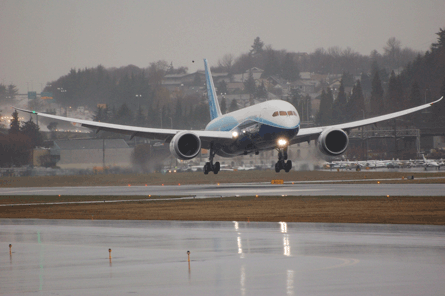For Boeing, first flight may have been the end of a long road to get the 787 flying, but the milestone signals a start of a gruelling flight-test programme to validate and certificate technologies never before seen on a commercial aircraft.
Boeing hopes to complete the 6,800h, six-aircraft flight and ground test programme in eight and a half months, which would be the fastest certification completed for any clean-sheet commercial aircraft in the company's history.
Programmes sources say the first four machines will be flying by February and all six will be flying by April.
Ship one - dubbed ZA001 - will be joined by ZA002 as early as this week according to vice-president of airplane programmes Pat Shanahan.
 |
|---|
© Jon Ostrower/Flightglobal |
Programme sources have told Flight International that Boeing aims to make its first delivery of a Trent 1000-powered 787 to All Nippon Airways by the end of September 2010. When the company readjusted its schedule on 27 August following the disclosure of the side-of-body modification in June, an additional margin of three months was added to the flight-test programme.
Boeing's target for first delivery remains the fourth quarter of 2010, a reflection of that added margin.
Frank Rasor, director of flight test operations, acknowledged in April the 8.5-month test plan had a 15-20% margin built in, even before Boeing added the additional three months in August.
A dream delayed: from first assembly to first flight in 31 months 2007
2008
2009
|
The ambitious schedule is driven by a new flight-test methodology that seeks to exploit the non-flying hours while the aircraft is on the ground.
By leveraging the ground hours, Boeing is able to maintain the same number of expected flight test hours as previous programmes and what is known as "discovery" layup, or times when unexpected events arise requiring a modification to the aircraft.
With those expectations using past programmes as precedent, Boeing is able to reduce the "planned" layup time by streamlining preparations that require the aircraft to be taken out of flight rotation for anticipated modification for specific types of testing.
For example, Rasor says: "Now we have prefabricated pressure belts with internal electronics [for flight loads survey]. We simply tape [prefabricated ice shapes] on the wing and we're ready to go. It's about a seven-day process, so we've specifically taken action to reduce that amount of layup time."
Rasor added that these installations took 30 days in previous programmes.
Ground testing, Rasor says, will be moved from daylight hours to evening hours.
"We're going to move more ground tests to second shift, so when you hear words like "24/7 flight testing", [we mean] between airborne tests, ground tests and maintenance and reconfiguration of the airplane it will be a 24h operation. We typically fly daylight hours, unless there are tests specific to night-time."
The 3,100 flight and 3,700 ground test hours will be spread across six flight-test aircraft. The first four will fly with Rolls-Royce Trent 1000 engines and the remaining two will be powered by General Electric GEnx-1Bs.
The Trent 1000 fleet, ZA001, ZA002, ZA003 and ZA004, which will certificate launch customer All Nippon Airways' engine selection, will undergo the majority of the tests with 2,430 flight and 3,100 ground test hours.
The two GEnx-1B powered test aircraft, ZA005 and ZA006, will undergo a 670h flight and 600h ground test programme.
Boeing also anticipates conducting testing on the first two production aircraft, numbers seven (ZA100) and eight (ZA101), due to structural and electrical changes that will support the airworthiness certificate on the delivered aircraft.
With the flight-test programme under way, Boeing will spend the first two months getting a feel for the 787. Boeing will first work to prove the basic airworthiness of the aircraft by expanding the flight envelope at various air loads, gross weights, altitudes and airspeeds to clear any structural flutter, or natural vibration, from the aircraft.
Following these early tests, Boeing will move into the first phase of stability and control through stall testing that will ensure that behaves as expected various speeds and validate the primary flight control systems of the aircraft.
The initial test work aims to establish a final configuration of the aircraft before inviting the US Federal Aviation Administration in to conduct its type inspection authorisation. Once complete, the FAA will be invited on board the aircraft for formal certification operations during flight test.
Source: Flight International























